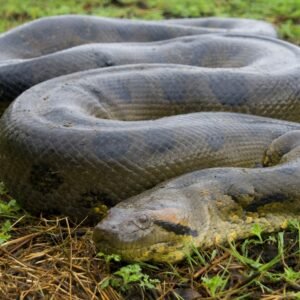
Why in news?
- Scientists have recently made a groundbreaking discovery in the Amazon rainforest, uncovering what is believed to be the world’s largest snake a new species of giant green anaconda. This remarkable find has captured global attention, prompting intense scrutiny and excitement within the scientific community. Researchers are now racing to gather more information about this colossal serpent, delving into its habitat, behavior, and evolutionary history to unlock the mysteries surrounding this awe-inspiring creature.
Discovery of New Green Anaconda Species in the Orinoco Basin
In a significant scientific breakthrough, researchers have identified a new species of green anaconda residing in the Orinoco Basin. This discovery sheds light on the rich biodiversity of the region and adds a new dimension to our understanding of these fascinating creatures.
Southern Green Anaconda (Eunectes murinus)
The Southern green anaconda, a species already known to science, inhabits regions in Peru, Bolivia, French Guiana, and Brazil. Renowned for its imposing size and strength, it has long been a subject of study and fascination.
Northern Green Anaconda (Eunectes akayima)
- Recently discovered, the Northern green anaconda occupies a vast range spanning Ecuador, Colombia, Venezuela, Trinidad, Guyana, Suriname, and French Guiana. Named for its geographical distribution, this newfound species is an exciting addition to the anaconda family.
-
Physical Resemblance and Characteristics :
- Both the Southern and Northern green anacondas share striking similarities in their physical appearance. Their olive-colored skin, adorned with large black spots, serves as an effective camouflage in their natural habitat, allowing them to blend seamlessly into the lush greenery of the rainforest.
Types of Anaconda
-
Green Anaconda (Eunectes murinus):
- Also known as the common anaconda, the green anaconda is the largest and heaviest snake species in the world by weight and girth.
- It typically inhabits swamps, marshes, and slow-moving streams in the Amazon and Orinoco basins of South America.
- Green anacondas are olive-green in color with black spots and can reach lengths of over 25 feet and weigh more than 500 pounds.
- They are powerful constrictors and primarily prey on large mammals, birds, and fish.
-
Yellow Anaconda (Eunectes notaeus):
- The yellow anaconda is smaller than its green counterpart but still ranks among the largest snake species in the world.
- It is found in the wetlands and marshes of South America, particularly in Argentina, Paraguay, and Brazil.
- Yellow anacondas have a yellowish-brown coloration with dark blotches and can grow to lengths of around 10-15 feet.
- They primarily feed on aquatic prey such as fish, amphibians, and small mammals.
-
Dark-Spotted Anaconda (Eunectes deschauenseei):
- Also known as the DeSchauensee’s anaconda, this species is much less well-known compared to the green and yellow anacondas.
- It is native to the tropical rainforests of northeastern South America, including parts of Brazil and Colombia.
- Dark-spotted anacondas have a dark brown or blackish coloration with lighter spots or blotches.
- They are smaller than green anacondas, typically reaching lengths of around 10-15 feet. Their diet likely consists of small mammals, birds, and reptiles.
-
Bolivian Anaconda (Eunectes beniensis):
- This species, also referred to as the Beni anaconda, was discovered relatively recently and is the least studied of the four anaconda species.
- It is found in the lowland forests and swamps of Bolivia and neighboring regions of Brazil.
- Bolivian anacondas have a similar appearance to green anacondas but may have distinct genetic and ecological differences.
- They are believed to grow to similar sizes as green anacondas and likely have similar feeding habits.
People also ask
Q1. How does the size of the newly discovered species of giant green anaconda compare to that of the previously known green anaconda?
Ans: The newly discovered species of giant anaconda is believed to rival or even surpass the size of the previously known green anaconda. This comparison offers insights into the potential variations within the anaconda species and raises questions about the factors influencing their size variation.
Q2. What are some notable characteristics of the green anaconda that distinguish it from other anaconda species?
Ans: Green anacondas are renowned for their impressive size and robust build, making them the largest and heaviest snake species in the world. They are characterized by their olive-green coloration, adorned with dark blotches or spots, and their semi-aquatic lifestyle, often found in swamps, marshes, and slow-moving streams.
Q3. How do anacondas contribute to their ecosystems, and why are they considered apex predators?
Ans: Anacondas play a crucial role in regulating prey populations within their ecosystems, primarily preying on large mammals, birds, and fish. As apex predators, they help maintain the balance of their habitat by controlling the populations of their prey species. Additionally, their presence serves as an indicator of ecosystem health, reflecting the overall well-being of their surrounding environment.

